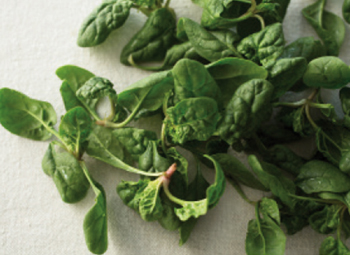SPINACH
WHEN I LIVED IN FRANCE, it was charming to me how vegetables—in this case spinach—have influenced the language. I love that vegetables were important enough for kings and queens to make a fuss over them and still feed the imagination of regular folks to create so many colorful slang expressions: Mettre du beurre dans les épinards means to “sweeten the pot,” in the sense of working another job, or overtime. I love that à la Florentine signifies that a dish focuses on spinach. Of all the greens that we commonly eat at home—like chard, kale, collards—spinach is the most accessible. Tender enough to eat raw, dense enough to enjoy wilted, packed with color to make bright purees, flavorful enough to stand up in a stir-fry, completely alive for fresh soups. It may be one of the world’s healthiest foods.
I love spinach because it’s so easy to understand and prepare, and it just tastes wonderful. Spinach is really a seasonal green, best enjoyed in the cooler, damp weather of spring and fall. I do not trust or enjoy prepackaged, prewashed bags or clamshells of spinach, now available under fluorescent lights 24/7 in big box stores everywhere. What I do not like about the aforementioned packaged greens, without even getting into how they’re produced, is that the leaves have lost every sign of vibrancy. A fresh bowl of beautiful spinach should actually make a kind of squeaking noise when you rub the leaves together. So buy your spinach fresh and alive, cook it right away, and eat it before it loses its glory.

Washing Greens

Spinach, like any leafy green, can be sandy, so it’s a good idea to make sure to rinse it thoroughly. Running water over the leaves in a strainer won’t clean them well enough. A better method is to fill a large bowl with water, add the leaves, swish them around with your hands several times, then pull them out and transfer to another large bowl of water. Repeating this one more time is usually enough to ensure bright green leaves with no grit. Now you’re ready to cook.
